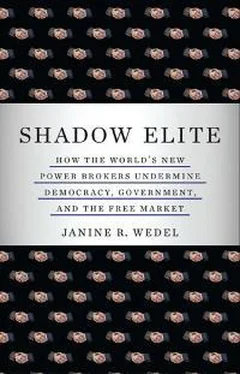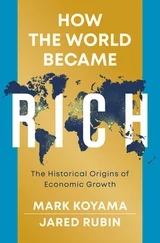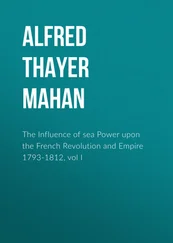In pooling roles, the Chubais-Harvard players also spun themselves through what I call a “collective revolving door” to keep the right people in the right positions to ensure continuity of goals—and to evade culpability. The players appear to have carefully coordinated their roles as they placed themselves in government and nongovernmental entities for maximum influence. The Chubais Clan moved its members around as they fielded accusations of corruption. Take the State Property Committee, headed by a succession of Clan members, including Chubais himself, Maxim Boycko, and Alfred Kokh. In 1997 Kokh was fired as head of the committee after it hit the press that he had accepted a $100,000 payment from a company that had received preferential treatment in a privatization scheme. Kokh was also charged with embezzlement of state property; the case was closed after Yeltsin granted him amnesty. The once U.S.-underwritten Kokh was denied entry to the United States in December 1999, though later he was allowed in. Boycko took Kokh’s place, only to be fired himself, also for accepting money for a privatization favor. The collective revolving door enabled the players to maintain a façade of respectability while retaining power. 37
This juggling of roles allowed the players to weave an economic base that afforded them independence. In addition to the aid-sponsored organizations and the hundreds of millions of aid dollars that the Chubais-Harvard partners managed, Chubais, with the involvement of Boycko and Kokh, set up several “foundations” with names like the Center for the Protection of Private Property and the Civil Society Foundation. While these entities were not much more than money-moving operations, and there is little to suggest that they played a role in policy, they bolstered the base of Chubais et al. 38
A flex net pools resources and positions players to expand its capacity for influence. When its players represent more than one country and can make decisions on behalf of one or another country, as did the Chubais-Harvard partners, the potential for influence without accountability is more easily achieved. These players’ ability to claim that they were making decisions on behalf of either nation, while in fact serving their transnational flex net, bolstered their influence and facility to serve their own agendas. 39
Institutionalized Ambiguity
The Chubais-Harvard players accomplished many of their goals through organizations that they set up and ran, ostensibly to carry out economic reform. These “flex organizations” (not to be confused with an informal flex net) help a flex net, whose members empower them, to amass information and resources, and to wield influence beyond accountability. The organizations not only harbor individuals whose multiple roles overlap and may be ambiguous; as entities, they are themselves ambiguous, neither clearly official nor private, but exhibiting features of both. 40
An archetypal flex organization was the donors’ flagship, the Russian Privatization Center, underwritten by a panoply of government and private sources, from the international financial institutions and the European Union to the United States, Germany, Japan, and the United Kingdom. Its work included policymaking on major macroeconomic issues, as well as negotiating loans with international financial institutions. Under its umbrella was a network of “local privatization centers” charged with developing restructuring plans for enterprises and advising local governments on policy questions. 41
Was the Center a state or a private entity? Legally, it was a nonprofit NGO set up by the Harvard Corporation, the university’s board of directors. (Center documents state that Harvard University was both a “founder” and “Full Member of the Center”—in fact, the “highest governing party of the Center.”) But perhaps it was a state entity, for the Center was mandated by Yeltsin’s presidential decree, and its U.S. sponsors (notably USAID) sometimes treated it as a government agency. USAID’s Tom Dine told me that he thought his agency saw the Center as a government organization and that Maxim Boycko, its longtime CEO, was a “government employee.” The international financial institutions, too, treated the Center as a government agency, negotiating with and lending it hundreds of millions of dollars, including from the World Bank ($59 million) and the European Bank for Reconstruction and Development ($43 million). A World Bank official told me that “we [the Bank] didn’t give [the loan] to [the Center] as a private organization but as an agent for the government of Russia . . . the government of Russia is responsible for paying it back.” Indeed, funding a nongovernmental entity is unusual for the bank, which typically negotiates with governments. 42
But while the Center seemed to have the rights of a government entity (in the eyes of some institutions), did it have the responsibilities of one? And while a slew of outside funders were underwriting the Center because it functioned as a state body, another slew of donors underwrote the Center for the opposite reason: It was an NGO. The Center received hundreds of millions of dollars from Western foundations and governments, many of which support NGOs because they regard them as building blocks of “civil society.” The Center’s flex quality helped it attract diverse funding. For the donors, it was a one-stop shop.
While the standing of the Center seesawed and was ambiguous, just who had influence wasn’t: Chubais served as chairman of the board of directors; Vasiliev, deputy chairman; Shleifer, Hay, and Åslund, members of the board; and Boycko, CEO. Members of the clan appointed one another to serve in the founding, governing, and management structure of the Center. During the height of the reform period it was the epicenter of much policy action and implementation, powered by the Chubais-Harvard net. 43
Flex organizations are also one-stop shops for the players themselves, providing convenient bases from which players can enact their less-than-official activities, often involving money. For instance, Hay was the subject of a civil suit under U.S. racketeering laws alleging that he used the Institute for Law-Based Economy (the USAID- and World Bank–created and funded flex organization run by the Chubais-Harvard team, and Hay specifically) to engage in fraud and money laundering involving a Russian bank. And how would anyone know this? Only because the allegedly defrauded party filed a lawsuit. 44
In part because their participants are so effective at personalizing bureaucracy and privatizing information, flex organizations themselves have little power or influence independent of their flex net. In fact, if members depart, they take their capacities with them. It is not an institution that is left behind, but an empty shell. This is but one reason why flex organizations must not be confused with static hybrids like the United Kingdom’s quangos or the United States’ Fannie Mae or Freddie Mac.
Supplanting the State
The Chubais-Harvard players achieved their aims by creating their own methods and vehicles (like flex organizations), to bypass or override official ones—or to simply stand in for the state. They also operated through presidential decree. These means undermined bureaucracy’s role in policymaking and implementation and helped the players relax rules at the interstices of official and private institutions—the fourth defining feature of flexians.
Flex organizations do more than enable their players to worm out of accountability through their might-be-state, might-be-private status; they supplant the state. The private Russian Privatization Center, for instance, had at its disposal sensitive information, “state” funds (supplied by international financial institutions), and other privileges of a state body, but without the accountability of one. Tellingly, this ostensible NGO was put in charge of the postprivatization restructuring of enterprises. Such a task would be a major responsibility of a denationalizing country, yet no government agency was charged with this mission. Through its network of satellite offices strategically placed around the country, the Center collected sensitive business and political information. It acquired more access to inside information about privatized companies and regional economic and political goings-on than did any governmental entity (except possibly state security bodies) or the relevant parliamentary committee. At the same time, the Chubais associates had their own political agendas for gathering such information, according to aid-paid consultants I talked with who helped set up and man the satellite offices. The local (Russian) directors of these offices were handpicked by Boycko, and, as one consultant remarked, “they did what Maxim wanted.” 45
Читать дальше












